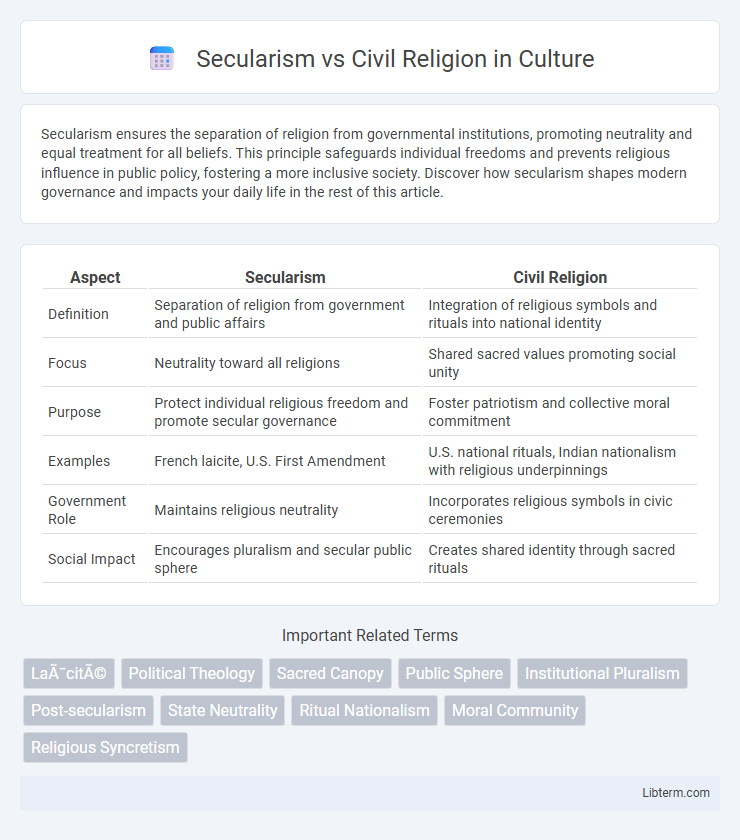Secularism ensures the separation of religion from governmental institutions, promoting neutrality and equal treatment for all beliefs. This principle safeguards individual freedoms and prevents religious influence in public policy, fostering a more inclusive society. Discover how secularism shapes modern governance and impacts your daily life in the rest of this article.
Table of Comparison
| Aspect | Secularism | Civil Religion |
|---|---|---|
| Definition | Separation of religion from government and public affairs | Integration of religious symbols and rituals into national identity |
| Focus | Neutrality toward all religions | Shared sacred values promoting social unity |
| Purpose | Protect individual religious freedom and promote secular governance | Foster patriotism and collective moral commitment |
| Examples | French laicite, U.S. First Amendment | U.S. national rituals, Indian nationalism with religious underpinnings |
| Government Role | Maintains religious neutrality | Incorporates religious symbols in civic ceremonies |
| Social Impact | Encourages pluralism and secular public sphere | Creates shared identity through sacred rituals |
Introduction to Secularism and Civil Religion
Secularism advocates for the separation of religion from governmental institutions and promotes a society where public policies are formulated without religious influence. Civil religion refers to a set of sacred beliefs and practices intertwined with national identity, often incorporating rituals, symbols, and ceremonies that unify citizens beyond individual faiths. Understanding secularism and civil religion highlights the balance between religious neutrality in governance and the use of shared values to foster social cohesion.
Historical Origins of Secularism
The historical origins of secularism trace back to the Enlightenment era of the 17th and 18th centuries, where thinkers like John Locke and Voltaire emphasized reason, individual rights, and the separation of church and state. Secularism emerged as a response to religious conflicts and theocratic rule, promoting a public sphere independent of religious authority. This development contrasted with civil religion, which integrates religious values into national identity and political institutions.
Evolution and Meaning of Civil Religion
Civil religion evolved as a sociopolitical framework that integrates sacred symbols, rituals, and myths into national identity, distinct from traditional secularism which advocates the separation of religion and state. It functions as a unifying force by providing shared beliefs and values that transcend individual religions, often manifesting in patriotic ceremonies and public symbols like the U.S. Pledge of Allegiance or national monuments. The meaning of civil religion highlights its role in creating collective cohesion through quasi-religious reverence for the nation, thereby influencing governance and social norms beyond the scope of secular neutrality.
Core Principles: Secularism Explained
Secularism emphasizes the separation of religion from governmental institutions, ensuring that public policies and laws are free from religious influence to maintain neutrality. It upholds individual freedom of belief by preventing any religion from becoming a state-endorsed faith. This principle supports pluralism and equal rights, fostering an inclusive society where all citizens participate regardless of religious affiliation.
Key Features of Civil Religion
Civil religion centers on shared beliefs, symbols, and rituals that promote national unity and moral order without explicit ties to organized religion. Key features include the sacredness of the constitution, patriotic ceremonies, veneration of founding figures, and the use of national symbols like flags and anthems to evoke collective identity. It functions as a unifying social framework that integrates religious sentiment with civic values, reinforcing loyalty to the state above particular religious doctrines.
Comparing Societal Roles: Secularism vs Civil Religion
Secularism emphasizes the separation of religion from governmental institutions, promoting a neutral public sphere where individual beliefs are private and diverse. Civil religion, by contrast, integrates shared rituals, symbols, and moral values into national identity, fostering social cohesion and collective meaning beyond formal religious doctrine. While secularism prioritizes individual freedom and pluralism, civil religion functions as a unifying framework that sustains societal solidarity through common patriotic and ethical commitments.
Impact on Governance and Public Policy
Secularism enforces a strict separation between religion and state, ensuring governance and public policy are based on universal laws and rational decision-making rather than religious doctrines, promoting inclusivity and equal treatment of all citizens. Civil religion integrates shared religious symbols and rituals into public life, which can strengthen national identity but may risk marginalizing minority beliefs and influencing policies with moral frameworks rooted in dominant religious values. The balance between these approaches affects the extent to which laws accommodate diverse religious expressions while maintaining state neutrality and fostering social cohesion.
Case Studies: Global Perspectives
Case studies from the United States highlight civil religion through national rituals and symbols reinforcing collective identity beyond traditional religions, while secularism emphasizes the separation of religion and state to maintain pluralism. In France, secularism, or laicite, strictly prohibits religious influence in public institutions, contrasting with India's civil religion approach that incorporates diverse religious practices into national identity. Brazil presents a hybrid model where secular state principles coexist with widespread religious expressions in public life, demonstrating varied global perspectives on managing religion's role in society.
Challenges and Controversies
Secularism faces challenges in maintaining a clear boundary between state and religion, often sparking controversies over religious symbols and practices in public spaces. Civil religion blurs these lines by incorporating shared rituals and values that invoke transcendent meanings, leading to debates about inclusivity and the potential marginalization of minority faiths. Conflicts arise from varying interpretations of secular neutrality and the role of national identity in public rituals.
Future Trends in Secularism and Civil Religion
Emerging trends indicate a growing diversification in secularism as societies increasingly emphasize pluralism and individual rights, leading to more inclusive public spaces detached from traditional religious frameworks. Civil religion evolves by integrating multicultural narratives and expanding symbolic rituals to foster social cohesion amid rising global interconnectivity. These dynamics suggest a future where secularism and civil religion coexist through adaptive frameworks that balance cultural heritage with evolving collective identities.
Secularism Infographic

 libterm.com
libterm.com